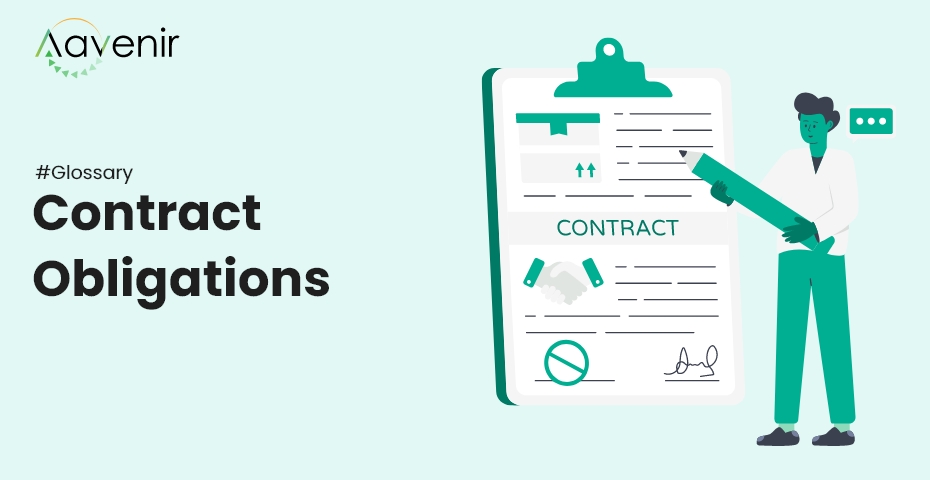Contract Obligations Explained: Types and Tips for Obligation Management
Managing contracts doesn’t end after the signature. For many teams—legal, procurement, sales, finance, and HR—the real challenge is making sure everyone delivers what the contract has committed to.
Missed obligations like delayed payments, poor service delivery, or unclear responsibilities often lead to internal confusion, vendor disputes, or even legal risk. These issues usually happen because contractual obligations aren’t clearly tracked or managed.

The good news? With the right understanding and tools, you can take control of your contractual obligations. That means fewer surprises, faster issue resolution, and more confident contract management.
In this blog, we’ll explain what contractual obligations are, why they matter, the types you should know about, and how to manage them effectively—so your team can stay proactive with managing contractual commitments. Let’s get started.
What are Contractual Obligations?
Contractual obligations are the specific responsibilities or actions that each party agrees to perform when they enter into a contract. These obligations are written into the contract and are legally binding, meaning both sides are required to follow through as agreed.
In simple terms, obligations define who needs to do what, by when, and under what conditions. Contractual obligations can cover a wide range of actions, including:
- Delivering goods or services
- Making timely payments
- Meeting performance benchmarks (e.g., SLAs)
- Maintaining confidentiality
- Complying with legal or regulatory standards
- Providing progress reports or documentation
In business, keeping track of these obligations is critical. Missed deadlines, overlooked deliverables, or unclear responsibilities can lead to penalties, legal issues, or strained relationships. That’s why obligation management is an essential part of contract lifecycle management.
6 Types of Contractual Obligations You Should Know
Contractual obligations can vary depending on the nature of the agreement and the goals of the parties involved. Whether you’re dealing with vendors, employees, or customers, it’s important to understand the different types of obligations that might appear in a contract.
Here are six of the most common types:
1. Payment Obligations
These are commitments related to transferring money from one party to another, usually in exchange for goods, services, or rights.
Examples of Payment Obligations
- Paying a supplier after goods are delivered
- Releasing milestone-based payments in a project
- Processing refunds under certain conditions
Missing payment obligations can result in penalties, late fees, or breach of contract.
2. Service/Delivery Obligations
This refers to the responsibility of one party (typically a vendor or service provider) to deliver specific goods or perform services as outlined in the contract.
Examples of Service/Delivery Obligations
- A contractor must finish construction by a specific date
- A software company must deliver an app version within 60 days
These obligations often specify deadlines, quality standards, delivery methods, and remedies if not fulfilled.
3. Confidentiality Obligations
These obligations protect sensitive information shared during a business relationship. The goal is to prevent unauthorized access, use, or disclosure of that information. This often applies to client data, business strategies, and intellectual property.
Examples of Confidentiality Obligations
- A software vendor signs a non-disclosure agreement (NDA) to keep a client’s product architecture confidential.
- An employee agrees not to disclose company financials or internal performance metrics to outsiders.
- A marketing agency is prohibited from sharing unpublished campaign ideas with other clients.
Contracts may define how long the confidentiality must be maintained and what exceptions (if any) apply.
4. Compliance Obligations
Compliance-related obligations ensure both parties follow applicable laws, regulations, and internal policies during the life of the contract.
Examples of Compliance Obligations
- Adhering to privacy laws like GDPR or HIPAA
- Following anti-corruption laws in international contracts
- Meeting company-specific security standards
Compliance obligations help avoid legal penalties, reputational harm, and operational disruptions.
5. Non-Competence or Exclusivity Obligations
These restrict a party from engaging with competitors or offering similar services for a defined period or in a specific market.
Examples of Non-Competence or Exclusivity Obligations
- A vendor may agree to sell exclusively to one distributor.
- An employee may be restricted from working with a direct competitor after leaving the company.
These clauses protect business interests, customer relationships, and intellectual property.
6. Reporting Obligations
These involve regularly providing updates or information as specified in the contract. They help maintain transparency and track performance.
Examples of Reporting Obligations
- Submitting quarterly performance reports
- Providing audit logs to verify compliance
- Sharing risk assessments in high-stakes vendor contracts
Well-defined reporting obligations make it easier to monitor accountability and take action when issues arise.
Why Proper Obligation Management is Critical to Contract Success
Managing contract obligations isn’t just a legal task—it’s a business necessity. When obligations go unnoticed, businesses can face delays, disputes, or even financial loss. Here are the 5 core benefits of proactively managing contract obligations:
1. Ensures Timely Deliverables and Milestone Fulfillment
Missed deadlines are common among businesses, especially when obligations are buried in lengthy contracts or scattered across spreadsheets. This can delay deliverables, impact project timelines, and frustrate clients or internal teams.
With proper obligation management, each deliverable is clearly tracked, assigned, and scheduled. Whether it’s a payment due, a shipment date, or a performance review, you get reminders and real-time updates to stay on track—no surprises, no delays.
2. Reduces Risk of Breach and Legal Disputes
Overlooking a single contractual duty, like failing to meet a service level or disclose required information, can lead to a breach of contract, resulting in penalties, legal action, and reputational damage.
Obligation management ensures that no commitment goes unnoticed. Businesses can catch issues early, keep every team member informed, and stay compliant with what’s written in the contract before things escalate.
3. Improves Vendor and Partner Accountability
When multiple vendors or departments are involved, it’s easy for obligations to become a game of “who’s responsible for what?” This lack of clarity can slow down execution and cause finger-pointing when things go wrong.
By assigning clear ownership for every obligation, you bring transparency and accountability to the table. Everyone knows what they’re responsible for—and when—making vendor relationships smoother and outcomes more predictable.
4. Supports Regulatory Compliance and Audit Readiness
Many industries—like healthcare, finance, and manufacturing—operate under strict regulations. Failure to meet a compliance obligation could result in hefty fines or audit failures.
A strong obligation management process (or tools like Aavenir Obligationflow) automatically tracks compliance clauses and deadlines. This makes it easy to stay aligned with legal requirements and respond quickly during audits, with the proof to back it up.
5. Aligns Contractual Duties with Business Goals
Sometimes, contract obligations are treated as isolated tasks, disconnected from larger business objectives. This leads to effort spent on things that don’t bring any significant business outcomes.
When obligations are tracked in context—with dashboards and performance metrics—they can be aligned with business priorities. That means contract execution directly supports cost reduction, risk management, or revenue growth goals.
Tired of Missed Contract Obligations?
Stay compliant and never miss a due date again. Automate obligation tracking with Aavenir Obligationflow’s smart reminders and workflows.
How to Ensure Meeting Compliance and Obligation
To ensure compliance with contract obligations, consider the following:
- Thoroughly review the contract: Carefully read and understand the contract terms, including the specific obligations and requirements. This will help you know what is expected and prevent any misunderstandings or omissions.
- Develop a clear plan: Create a detailed plan that outlines the necessary steps to fulfill each obligation. This plan should include timelines, resources needed, and responsible individuals or teams.
- Communication and coordination: Maintain open lines of communication with the other party/parties involved in the contract. Regularly update them on progress, seek clarification when needed, and address any potential issues or concerns proactively.
- Document and record-keeping: Maintain proper documentation of all activities, communications, and milestones related to the contract. This ensures a clear record of compliance and can be useful in case of any disputes or audits.
- Monitor and track progress: Regularly monitor and track the progress of obligations to ensure they are being fulfilled within the agreed-upon timeframes and standards. Identify and address any potential delays or obstacles promptly.
- Seek legal advice if necessary: If you have any uncertainties or encounter challenges in meeting your contract obligations, consult with a legal professional who can provide guidance and ensure compliance with legal requirements.
By understanding and actively managing your contract obligations, you can ensure the smooth and successful execution of the contract while minimizing the risk of disputes or non-compliance.
Best Practices for Managing Contractual Obligations
Whether you’re managing a few contracts or thousands, following these best practices will help you keep every obligation under control.
1. Centralize All Contracts in a Secure Repository
Store all your contract portfolio in one centralized contract repository system instead of scattered folders or inboxes. This makes it easier to locate key terms, track obligations, and ensure everyone’s working from the latest version. A secure, searchable repository eliminates confusion and speeds up reviews.
2. Clearly Define Obligations in the Contract Language
Avoid vague or broad terms when drafting contracts. Spell out who is responsible for what, by when, and under what conditions. Specific language reduces misunderstandings, ensures accountability, and makes it easier to extract and track obligations later.
3. Set Automated Alerts for Key Dates and Milestones
Use contract management tools to trigger alerts well before critical dates—like renewals, performance reviews, or compliance deadlines. Automated reminders help prevent delays, missed actions, and last-minute scrambles.
4. Assign Clear Ownership for Each Obligation
Every obligation should be assigned to a specific person or team. This creates accountability and eliminates confusion over who’s responsible for follow-through. Ownership also makes it easier to escalate issues if obligations are at risk of being missed.
5. Use Software to Automate Obligation Management
Manual tracking doesn’t scale when you are dealing with thousands of contracts. Use a contract obligation management platform like Aavenir Obligationflow to automatically extract obligations, assign owners, send reminders, and track fulfillment across the contract lifecycle. This saves time, reduces risk, and ensures nothing slips through the cracks.
Turn Every Obligation into a Tracked Task
Aavenir Obligationflow helps you convert contractual obligations into actionable items with automated alerts, assignments, and AI-powered dashboards.
Stay Ahead of Every Obligation with Aavenir Obligationflow
Managing contract obligations manually is risky—things get missed, deadlines slip, and accountability breaks down. Aavenir Obligationflow eliminates that risk by giving you full visibility and control over every obligation in every contract.
Here’s how Aavenir helps you stay on top of it all:
- Auto-extract obligations using AI—no manual review needed
- Assign ownership to teams or individuals instantly
- Set alerts and reminders for key dates and milestones
- Track obligation status with real-time dashboards
- Integrate with tools like ServiceNow, SAP, and Oracle
With Aavenir, obligation management isn’t just easier—it’s proactive, automated, and audit-ready. Book a demo today to see how Aavenir Obligationflow can streamline your obligation management.

